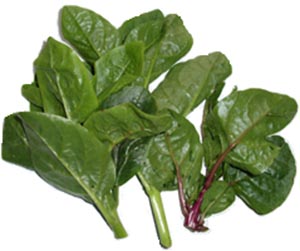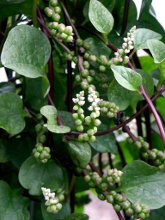Basella (vine spinach) nutrition facts
Basella, also known as vine spinach, is a popular tropical leafy-green vegetable often cultivated as a backyard herb in home gardens.
Vine spinach belongs to the Basellaceae family and comprises two main cultivars: Basella alba, characterized by green stems and deep-green leaves, and Basella rubra, distinguished by purplish stems and dark green leaves with pink veins.
Originating from South Asia, it likely originated in the monsoon-fed tropical regions of the Malabar Coast of India and Sri Lanka. Throughout Asia, basella goes by various names. Commonly referred to as Ceylon spinach, Malabar spinach, saan choy (in Chinese), mong toi (in Vietnamese), alugbati (in the Philippines), Pui saag (in Bengali), remayong (in Malay), and more.
 |
| Vine spinach. Note- Basella alba and B. rubra types; green and pink stems respectively. |
Distinct from English spinach (Spinacea oleracea), Malabar spinach is characterized by its creeping growth habit, boasting vibrant, broad, dark green leaves that are thick and mucilaginous. While it is a staple in many South Asian households' backyards, it is gradually garnering attention in select tropical and temperate climates of America, Australia, and Europe due to its lush, nutritious greens and tender stems.

|
| Malabar-spinach (Basella rubra) vine. Note pink stems and green leaves. Photo courtesy: scott.zona |
Malabar spinach, a perennial vine, is typically cultivated as an annual or biennial pot-herb. Thriving in hot, humid climates and moist, fertile, well-drained soil, it requires optimal conditions to flourish. For natural propagation and expedited growth, stem cuttings around 20 cm in length are preferred over seeds. Due to its vining nature, trellising is essential for its rapid expansion. Depending on the species, it produces tiny flowers ranging from white to white-pink and purple to black-colored berries.
Basella alba exhibits thick, fleshy, broad, oval to heart-shaped leaves along its vine's length. Conversely, Basella rubra displays pink or purplish stems and pink-colored veins traversing its leaves. In both cases, the harvest consists of fleshy greens and terminal, tender stems measuring 8-12 inches, typically ready for harvest 35 to 45 days after planting (around 50 days after seeding).
Health Benefits of Basella (Vine Spinach)
Basella is revered in some East Asian cultures for its versatile phytonutrient profile.
With just 19 calories per 100 grams of raw leaves, Basella is low in calories and fats yet rich in vitamins, minerals, and antioxidants.
Fresh leaves, particularly those of Basella rubra, boast essential carotenoid pigment antioxidants like ß-carotene, lutein, and zeaxanthin, offering protection against free radicals and reactive oxygen species, which contribute to aging and disease.
Its thick, fleshy leaves are abundant in non-starch polysaccharides and mucilage, aiding in digestion and reducing cholesterol absorption, thus preventing bowel issues.
Vine spinach leaves and stems are high in vitamin A, providing 8000 IU or 267% of the recommended daily allowance, crucial for healthy skin, mucous membranes, and vision, with potential protective effects against certain cancers.
Basella surpasses English spinach in vitamin C content, offering 102 mg or 102% of the daily recommended levels, bolstering the body's immune system and neutralizing harmful free radicals.
Like spinach, Basella is an excellent source of iron, providing 1.20 mg or 15% of the daily intake, vital for red blood cell production and cellular metabolism.
It contains significant amounts of B-complex vitamins such as folate, essential for DNA synthesis and growth, crucial during pregnancy to prevent neural tube defects.
Basella leaves are rich in minerals like potassium, manganese, calcium, magnesium, and copper, supporting heart health, antioxidant defenses, and overall well-being.
Regular consumption of Basella in the diet, akin to spinach, aids in preventing osteoporosis, iron-deficiency anemia, cardiovascular diseases, and colon cancers.
| Principle | Nutrient Value | Percent of RDA |
|---|---|---|
| Energy | 19 Kcal | 1% |
| Carbohydrates | 3.40 g | 2.5% |
| Protein | 1.80 g | 3% |
| Total Fat | 0.30 g | 1.5% |
| Cholesterol | 0 mg | 0% |
| Vitamins | ||
| Folates | 140 µg | 35% |
| Niacin | 0.500 mg | 3% |
| Pantothenic acid | 0.053 mg | 1% |
| Pyridoxine | 0.240 mg | 18% |
| Riboflavin | 0.155 mg | 13% |
| Thiamin | 0.050 mg | 4% |
| Vitamin A | 8,000 IU | 267% |
| Vitamin C | 102 mg | 170% |
| Electrolytes | ||
| Sodium | 24 mg | 1.5% |
| Potassium | 510 mg | 11% |
| Minerals | ||
| Calcium | 109 mg | 11% |
| Copper | 0.107 mg | 12% |
| Iron | 1.20 mg | 15% |
| Magnesium | 65 mg | 16% |
| Manganese | 0.735 mg | 32% |
| Selenium | 0.8 µg | 1.5% |
| Zinc | 0.43 mg | 4% |
Selection and storage
Fresh Malabar spinach is readily available in the tropical belt throughout all seasons. However, in the US and European markets, only selected groceries specializing in selling Asian vegetables and herbs offer fresh basella greens (both green and purple). When in stores, look for a fresh harvest featuring shiny, succulent leaves, and firm stems. The green itself has no distinctive flavor, but once cooked, it mixes well with other ingredients, in addition to conferring a gel-like consistency to the dish.
Avoid purchasing sunken, dry, bruised, and discolored leaves.
Basella has a relatively good shelf life. At home, untie the bunch, wrap the leaves in a damp cloth, place them in an air-tight zip-pouch or plastic bag, and store them in the refrigerator set at high relative humidity.
Although the greens can be stored in the fridge for up to four days, fresh leaves should be eaten at the earliest to maximize nutritional benefits.
Preparation and serving methods
To remove any surface grit or sand, wash the leaves in cold running water. Then, pat them dry using a paper towel or soft cotton cloth. Trim away any tough stems and chop the leaves and stems to the desired length for your recipes.
Vinespinach can be used in the same way as other seasonal greens such as spinach, watercress, and purslane. However, due to its more mucilaginous nature, it adds a thick, glue-like consistency to dishes.
Here are some serving tips:
The greens are often mixed with other popular greens to prepare "saag" in India and Bangladesh (pui shaak), sometimes with added lentils or seafood. Additionally, its flower and seed heads (pui seeds) are edible and used in recipes featuring seasonal seafood.
In southern parts of India, Malaysia, Indonesia, China, and Sri Lanka, the leaves and stems are utilized in various dishes including curries, stews, soups, and more. They are commonly served with rice, bread (roti), and noodles.
In the Philippines, where the greens are known as alugbati, they are used to create delicious stir-fries with meat and vegetables.
Malabar spinach berries are used in fragrant-rich chutney in many coastal areas of Karnataka and Coorg districts. Additionally, the berries are employed in jams and jellies in Sri Lanka.
Safety profile
Phytates and dietary fiber found in the leaves can hinder the absorption of iron, calcium, and magnesium.
Similar to spinach, basella alba also contains oxalic acid, a naturally occurring substance found in some vegetables, which may lead to the formation of oxalate stones in the urinary tract for some individuals. Those with known oxalate urinary tract stones are advised to avoid consumption. Maintaining adequate water intake is encouraged to support normal urine output. (Medical disclaimer)
≻≻-Back to Vegetables from Basella. Visit here for an impressive list of vegetables with complete illustrations of their nutrition facts and health benefits.
≻≻-Back to Home page.
Further resources: